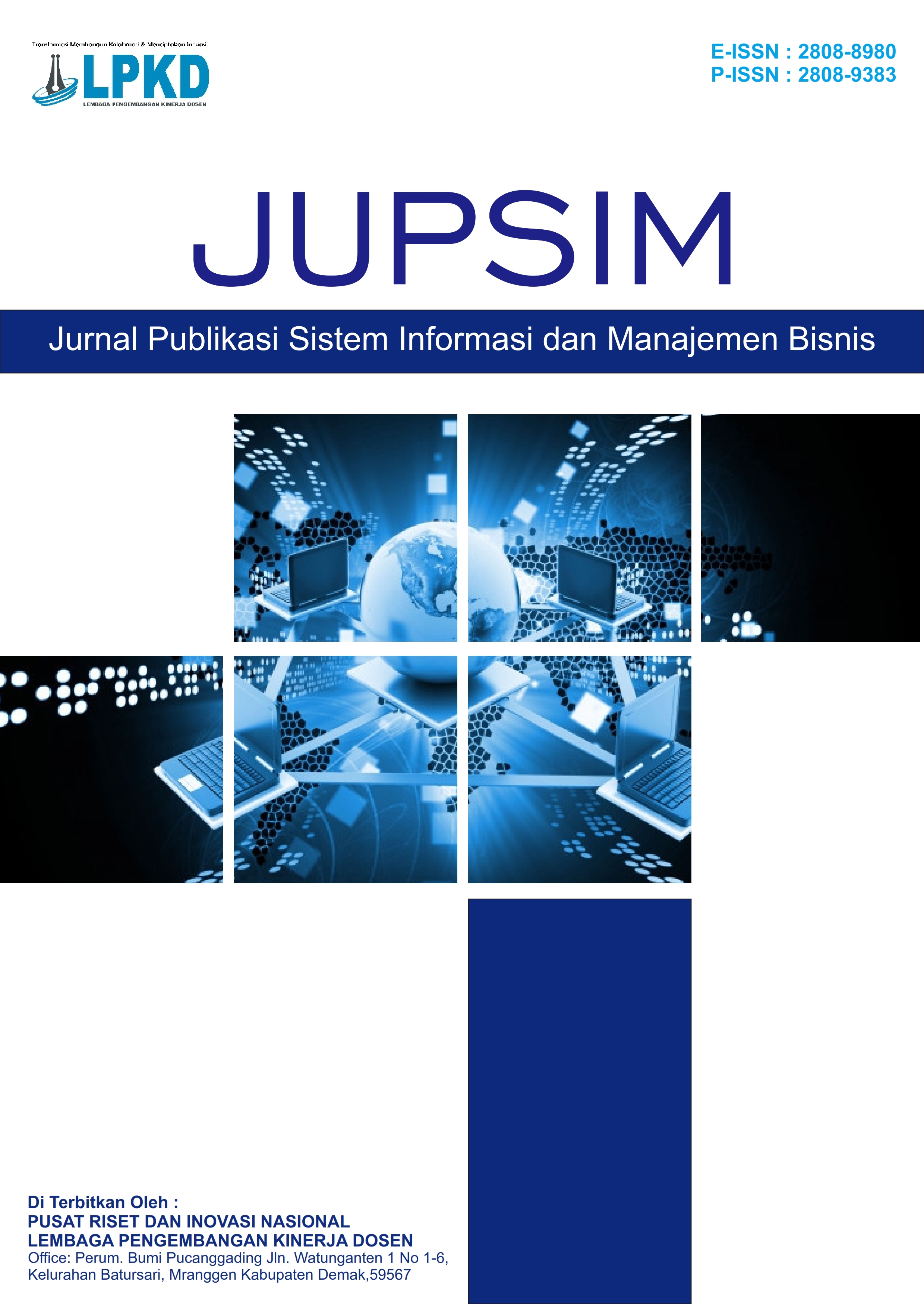Eksplorasi Penerimaan Aplikasi Pegadaian Digital Service (PDS) Melalui Model UTAUT3 dan Trust
DOI:
https://doi.org/10.55606/jupsim.v4i3.5516Keywords:
Effort Expectancy, Personal Innovativeness, Social Influence, User Acceptance, User HabitAbstract
This study aims to evaluate the factors influencing user acceptance of the Pegadaian Digital Service (PDS) application by applying the UTAUT3 framework with the addition of the Trust variable. Based on interview findings and user review analysis, PDS adoption remains relatively low due to initial access difficulties, inconsistent navigation, and concerns regarding data security. The research employed a quantitative approach with 100 active PDS users as respondents. The collected data were analyzed using the SEM-PLS method. The results indicate that Effort Expectancy, Social Influence, and Personal Innovativeness significantly affect Behavioral Intention, while Habit has a significant effect on Use Behavior. In contrast, Performance Expectancy, Facilitating Conditions, Price Value, Trust, and Behavioral Intention do not significantly influence Use Behavior. The model demonstrates moderate explanatory power (R² = 0.555 for BI and 0.274 for UB). These findings suggest that, in collateral-based financial services such as PDS, behavioral intention alone is insufficient to drive actual usage without adequate supporting conditions. The practical implications highlight the importance of improving user experience, strengthening socially driven campaigns, and fostering user habits through digital incentives to enhance PDS adoption.
References
Anugrah, Z., Suhaebah, L., Pramudita, T. R., & Yusuf, R. (2024). Pengaruh performance expectancy, effort expectancy, social influence pada behavioral intention aplikasi Gojek di Kabupaten Garut. ANALYSIS: Accounting, Management, Economics, and Business, 2(1), 34–42. https://doi.org/10.56855/analysis.v2i1.908
Asmita, A., & Hamid, R. S. (2022). Peran effort expectancy, facilitating conditions, price value dalam menentukan behavioural intentions pada nasabah pengguna mobile banking. Owner, 7(1), 322–332. https://doi.org/10.33395/owner.v7i1.1263
Azam, S. M. F., Khatibi, A., Gunasinghe, A., & Abd Hamid, J. (2019). The viability of UTAUT-3 in understanding the lecturers’ acceptance and use of virtual learning environments. International Journal of Technology Enhanced Learning, 1(1), 1. https://doi.org/10.1504/ijtel.2019.10023751
Hair, J. F., Hult, G. T. M., Ringle, C. M., & Sarstedt, M. (2022). A primer on partial least squares structural equation modeling (PLS-SEM). https://lccn.loc.gov/2021004786
Kristi, N., Shiddieq, D. F., & Nurhayati, D. (2024). Analisis penerimaan aplikasi Flip menggunakan model Unified of Acceptance and Use of Technology 3. MALCOM: Indonesian Journal of Machine Learning and Computer Science, 4(2), 685–694. https://doi.org/10.57152/malcom.v4i2.1316
Maulani, E., & Handayani, S. S. (2023). Analysis of the application of the Unified Theory of Acceptance and Use of Technology 3 (UTAUT-3) model on intention and use behavior of users of mobile banking applications in the Jabodetabek region. International Journal of Social Science and Human Research, 6(9), 5465–5475. https://doi.org/10.47191/ijsshr/v6-i9-17
Mulazid, A. S., Saharuddin, D., Muttaqien, M. K., Wicaksono, A. T. S., Fatmawati, F., & Fauzan, F. (2024). Determinants for acceptance and use of Sharīʿah banking digital services in Indonesia: Applying UTAUT 3, trust, and Sharīʿah compliance. Journal of King Abdulaziz University: Islamic Economics, 37(1), 55–77. https://doi.org/10.4197/Islec.37-1.4
Mulyani, F., & Haliza, N. (2021). Analisis perkembangan ilmu pengetahuan dan teknologi (Iptek) dalam pendidikan. Jurnal Pendidikan dan Konseling (JPDK), 3(1), 101–109.
Paramita, E. D., & Cahyadi, E. R. (2024). The determinants of behavioral intention and use behavior of QRIS as digital payment method using extended UTAUT model. Indonesian Journal of Business and Entrepreneurship. https://doi.org/10.17358/ijbe.10.1.132
PlayStore, G. (2025). Ulasan pengguna – Pegadaian Digital Service.
Prabu, A., Nurhaliza, S., & Indonesia, U. (2024). Digital transformation in the financial sector: Implications for consumer trust and security.
Rabiah, A. S., Setiawan, M., Rohman, F., & Mugiono. (2024). Assess the impact of hedonic motivation, social influence, gamification, and education level on behavioral intention to adopt mobile shopping in Jakarta, Indonesia. Revista de Gestão Social e Ambiental, 18(7), 1–24. https://doi.org/10.24857/RGSA.V18N7-008
Rasulong, I., Salam, R., Yusuf, M., & Abdullah, I. (2024). Implikasi kepribadian Gen Z bagi daya saing organisasi: Suatu kajian systematic literature review. Liquidity: Jurnal Ilmu Manajemen dan Bisnis, 2(2). https://jurnal.usy.ac.id/index.php/liquidity/article/view/46
Rauf, R., Idris, F. P., Baharuddin, A., Amelia, A. R., & Ahri, R. A. (2025). Pengaruh motivasi hedonis dan kebiasaan terhadap perilaku pengguna melalui niat pengguna rekam medis elektronik berbasis model UTAUT 2 di RSUD Lamaddukkelleng. 6(1), 1–14.
Samarinda, M. I. (2024). Relationship between performance expectancy and behavioral intention: A systematic literature review. 12(3), 334–340.
Sofyan, M. R., & Hasibuan, A. (2024). Transformasi digital dalam industri layanan keuangan: Implikasi dan tantangan bagi sektor manufaktur. Kohesi: Jurnal Multidisiplin Saintek, 2(4), 80–89.
StatCounter. (2025). Mobile vs desktop vs tablet market share Indonesia.
Wibowo, N. A. P., & Sobari, N. (2023). The influence of behavioral intention, facilitating condition, and habit on use behavioral of QRIS: A study on mobile banking services. Gema Wiralodra, 14(3), 1243–1258. https://doi.org/10.31943/gw.v14i3.482
Wu, Q., Tian, J., & Liu, Z. (2025). Exploring the usage behavior of generative artificial intelligence: A case study of ChatGPT with insights into the moderating effects of habit and personal innovativeness. Current Psychology. https://doi.org/10.1007/s12144-024-07193-w
Yu, T., Teoh, A. P., Wang, C., & Bian, Q. (2024). Convenient or risky? Investigating the behavioral intention to use facial recognition payment in smart hospitals. Humanities and Social Sciences Communications, 11(1), 1–20. https://doi.org/10.1057/s41599-024-03910-9
Downloads
Published
How to Cite
Issue
Section
License
Copyright (c) 2025 Jurnal Publikasi Sistem Informasi dan Manajemen Bisnis

This work is licensed under a Creative Commons Attribution-ShareAlike 4.0 International License.







